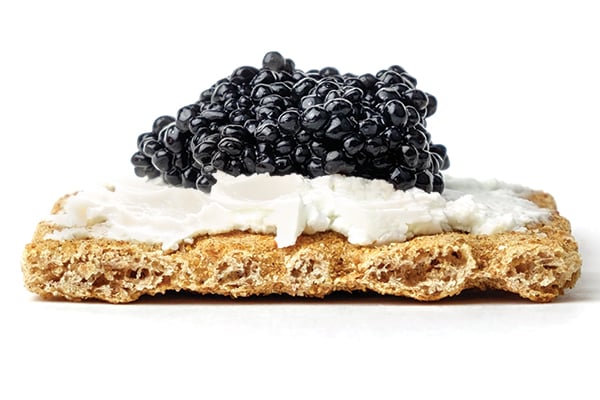
The Great 28 is featured in our Cheese+ 2017 issue. Check out 27 other pairings here.
Your exposure to salt-cured fish eggs, a.k.a. caviar, typically determines your comfort level. If you come from a place where roe is a regular dinner guest (Japan, Korea, or Russia), then it’s no big deal. But in the US, caviar is often considered a rich man’s (icky) folly. Perhaps dairy is just the cushion we need to embrace these aqueous eggs.
The most rarefied types come exclusively from wild sturgeon in the Caspian and Black Seas (beluga, osetra, and sevruga are the most common species found there). But during the past decade—following a 2005 US Fish and Wildlife Service ban on wild caviar imports, a response to overfishing—American producers have ramped up sturgeon farming and reshaped the entire domestic market, from production to consumption. Robert Gardner, whose American Caviar Company sells domestic wild and farmed caviar to restaurants, is succinct: “Farmed caviar is becoming so plentiful and inexpensive that legal wild caviar is becoming less and less important.” In other words, roe’s going mainstream.
Chefs are leading the charge for caviar’s democratization. By using the pearls in surprising and unexpected ways, these culinary trailblazers are giving diners a new entry point to this lesser-known ingredient. And dairy is often a go-to accompaniment. Justin Shoults, chef at Oak + Rowan in Boston, plates caviar with cultured butter and buttermilk puree. “Caviar and dairy naturally go well together,” he says. “Because caviar is lean, something fatty and creamy really adds to it, counteracting and balancing the saltiness so that you pick up the nuances of sweetness and nuttiness of the roe.”
Chef Markus Glocker of Bâtard—home to one of the best cheese programs in New York City—says finding the right dairy for a specific type of caviar can be as nuanced as matching cheese and wine. “When using trout or salmon roe, I prefer to use a lighter dairy like yogurt or buttermilk to pair with it since I enjoy having a light acid to enhance the flavor of the roe,” Glocker says. Extra-briny black caviar, he continues, goes perfectly with richer fare such as crème fraîche or sour cream.
Crème fraîche, of course, is part of traditional caviar service: The briny beads offer just a touch of textural resistance when they burst on the tangy, smooth canvas of cultured cream. It’s not much of a leap to cheese. For starters, try a milky, fresh cheese with milder roe. But once you have your sea legs, you can match fish eggs with all manner of dairy, from sour cream and burrata to complex, fudgy blues.
Trout Caviar
At about $15 an ounce, large, bright orange trout caviar is a mild introduction to the world of fish eggs. Paired with creamy, milky burrata, it’s a study in contrast: The “pop” of the roe is cushioned by the silkiness of the cheese. Layer it with The White Moustache Plain Labneh for a next-level parfait that’s equal parts tart, creamy, and briny.
Recommended Pairings:
BelGioioso Cheese Burrata + trout caviar
The White Moustache Plain Labneh + trout caviar

Photo credit: Iurii Stepanov/Shutterstock.com
American Paddlefish Caviar
No need to be spendy when pairing with caviar: Decatur Dairy Havarti Dill is smooth and herbal, with just enough tang to round out the earthy flavor of American paddlefish caviar sourced from swimmers native to the Mississippi River basin. This roe also has a creamy dimension only enhanced by havarti’s buttery vibe. For a study in more decadent textural contrast, match paddlefish eggs with Frost, a lush, cakey wheel from Mystic Cheese Company.
Recommended Pairings:
Decatur Dairy Havarti Dill + American paddlefish caviar
Mystic Cheese Company Frost + American paddlefish caviar
Wasabi Tobiko
Most often found in Japanese cuisine, tobiko are flying fish eggs. When infused with wasabi, the tiny, almost crunchy eggs take on a fabulous green hue (think Pop Rocks of the sea)—serve them with robust blues for a varsity-level combo that will excite turophiles and aspirants alike. First up, Sequatchie Cove Creamery Shakerag Blue: The green pearls are visually arresting against the rich, marbled paste, and the cheese’s savory, almost meaty flavors balance the spicy roe. For a milder matchup try the zippy ova with Westfield Farm Classic Blue Log—the externally rinded chèvre has an earthy funk to mellow things out.
Recommended Pairings:
Sequatchie Cove Creamery Shakerag Blue + wasabi tobiko
Westfield Farm Classic Blue Log + wasabi tobiko



